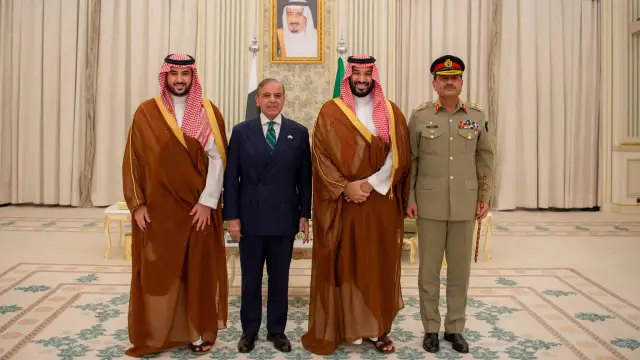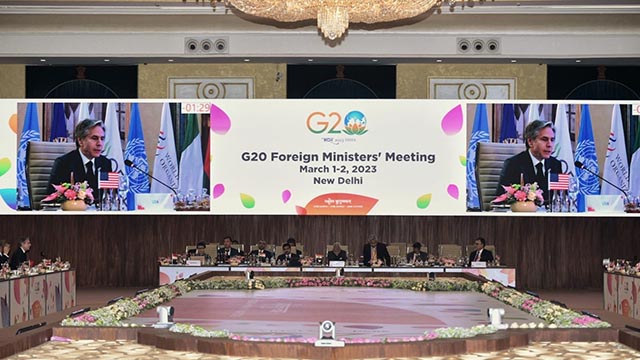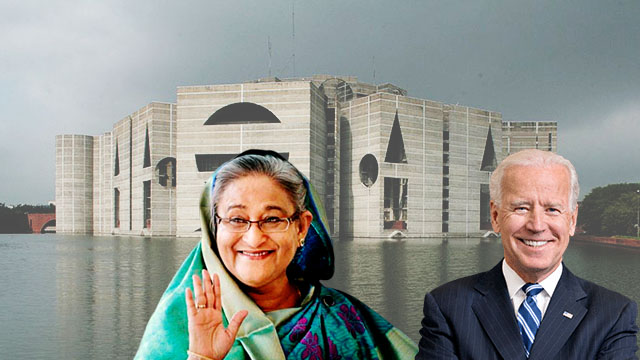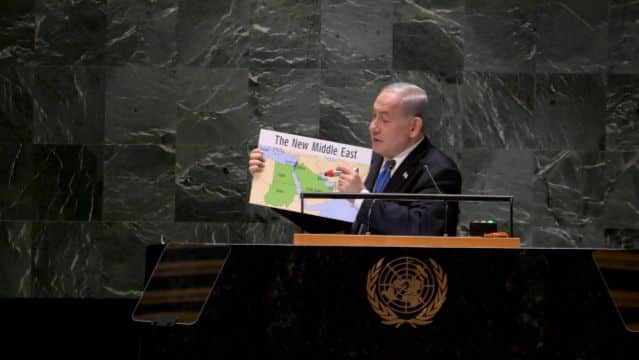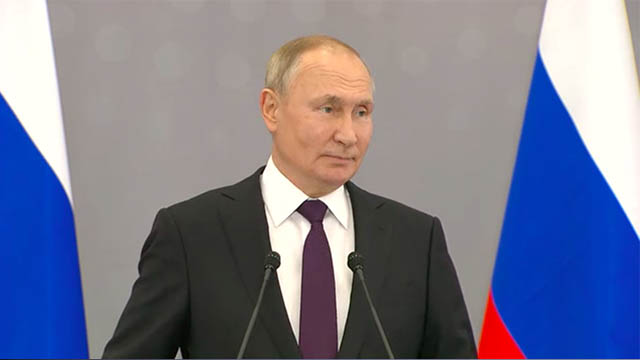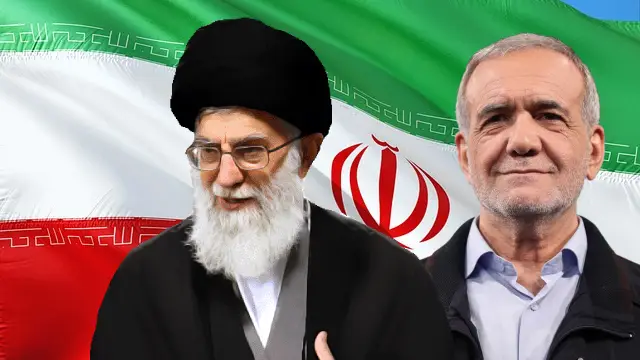A controversy has erupted in West Asia and South Asia after Pakistan and Saudi Arabia signed a mutual defence pact. The agreement, which states that any aggression against either country shall be considered an aggression against both, has caused concerns for the West.
Pakistan is also reportedly bringing Saudi Arabia under its nuclear umbrella, the country’s officials stated. This means West Asia’s richest monarchy is also going to have a nuclear backup. This development triggers concerns for not only Israel, the region’s sole unofficial nuclear state, but also for the US, which exerts immense influence on Saudi Arabian rulers.
While the agreement is beneficial for both countries in terms of enhancing security, it’s going to help Pakistan rejig its economy with Saudi Arabia’s help. Islamabad has gained on multiple fronts by signing this mutual defence pact.
First, Pakistan demonstrated that India’s attempts to isolate it have failed. India had accused Pakistan of sponsoring Islamist terrorism in South Asia and beyond.
Saudi Arabia is a close ally of India. Prime Minister Narendra Modi has visited Riyadh thrice in the last ten years.
Mr Modi sent MPs from all parties to Saudi Arabia. This formed part of efforts to highlight Pakistan’s role in the Pahalgam terrorist attack. The government also wanted to showcase India’s achievements during “Operation Sindoor”, the four-day border skirmish in May.
Despite all these, as Saudi Arabia embraces Pakistan, apparently in a bid to safeguard itself from any future Israeli attack, Mr Modi’s foreign policy faces severe embarrassment.
Secondly, Pakistan uses Saudi Arabia as a pawn, capitalising on the mutual defence pact, to thwart any future military strikes by India. The optics of Pakistani Prime Minister Shehbaz Sharif hugging the kingdom’s de facto ruler, Mohammed Bin Salman, have been used as a deterrent against India.
Finally, in return for Pakistan offering nuclear protection to Saudi Arabia under the mutual defence pact, it expects the kingdom to catapult its crisis-ridden economy. Pakistan has been relying on Saudi bailout for a long time, as its economy deteriorates. While Islamabad offers Riyadh its nuclear umbrella, the latter supplies oil and financial support. As Pakistan suffers from natural disasters and its economy relies more on foreign loans, the energy security offered by Saudi Arabia offers a crucial cushion.
Although these optics around Pakistan and Saudi Arabia signing the mutual defence pact have sparked concerns, the entire framework has been wrongly presented across the global mainstream media spectrum, especially in South Asia.
What does the Pakistan-Saudi Arabia mutual defence pact entail?
According to a joint statement, Pakistan and Saudi Arabia have signed a mutual defence pact to enhance their security.
“This agreement, which reflects the shared commitment of both nations to enhance their security and to achieving security and peace in the region and the world, aims to develop aspects of defence cooperation between the two countries and strengthen joint deterrence against any aggression. The agreement states that any aggression against either country shall be considered an aggression against both (sic),” the joint statement said.
According to experts, this agreement resembles the foundation of the US-led North Atlantic Treaty Organization (NATO). An attack on any NATO member is also considered an attack on all.
While citing this mutual defence clause, it has been claimed that in case India enters into a skirmish with Pakistan in the future, then it will also drag in Saudi Arabia, a close ally, into the conflict.
Many have also claimed that the treaty provides leverage to Saudi Arabia, as it can use Pakistan against Yemen’s ruling Ansar Allah if there is an attack on the kingdom. After fighting over Yemen’s control for years, Saudi Arabia has suffered losses and has entered into a temporary ceasefire with the Ansar Allah. Although Pakistan had been approached by Saudi Arabia and the UAE to join them against Yemen in 2015, the Pakistani parliament had rejected the proposal.
However, the treaty entails no provisions which say one party will fight the other’s war.
Each party may consider an attack on its partner as an attack on itself. However, neither country must fight for the other.
This means, in case of an India-Pakistan flare-up or a Yemen-Saudi conflict, Riyadh and Islamabad are not under any compulsion to fight that battle, but to provide support to the other party.
The unavailability of any enforcing mechanism means that Pakistan and Saudi Arabia have signed a mutual defence pact that plans to act as a deterrent rather than an actual deterrent to foreign aggression.
Why did Pakistan and Saudi Arabia sign the mutual defence pact?
Although Pakistan and Saudi Arabia have signed the mutual defence pact in the backdrop of the Israeli attack on Qatar, to showcase it as a deterrent, in reality, the circumstantial evidence shows a different trajectory of developments leading to the signing of the document.
Pakistan and Saudi Arabia signed their mutual defence pact as US President Donald Trump began demanding control of Bagram airbase from the Taliban.
Mr Trump, who had a telephonic conversation with Chinese President Xi Jinping recently, has mentioned that the US needs Bagram airbase because it’s close to where China manufactures its nuclear weapons.
Meanwhile, Pakistan has strong ties with China and the US. It had helped both kickstart their bilateral relations in 1971. Now, the China-Pakistan Economic Corridor (CPEC) has become a key route to transport Chinese goods to Pakistan’s Gwadar Port in the restive Baluchistan province.
With Pakistan and Saudi Arabia entering a bilateral and mutual defence pact, it will become easier for China to market its weapons to the kingdom, which has now acquired Chinese laser anti-drone technology to combat the Yemeni threat.
Saudi Arabia can now also easily use the CPEC to receive weapons.
This makes it imperative for the US, which is also a key supporter of Pakistan, to keep a watch on China-Saudi weapon deals.
China also has a strong military tie-up with Pakistan, and the latter has been receiving much of its arsenal from Beijing.
This necessity prompts Washington to demand control of the Bagram airbase from Afghanistan.
However, as neither Pakistan nor Saudi Arabia would like to irk the US, they have to also use the defence pact to indicate towards other possibilities in the region, including countering an Iranian or Yemeni aggression against Saudi Arabia.
In any case, for the sake of Israel, the US would enter negotiations with Pakistan and Saudi Arabia regarding their mutual defence pact. This will provide an ample opportunity to use the deal as a bargaining chip.
As Pakistani and Saudi diplomacy relies heavily on multilateral exchanges, each would likely use the deal and its potential for West Asia to cut a deal with the US.
How does Pakistan derive benefits?
Pakistan derives more benefits than Saudi Arabia from the mutual defence pact.
Firstly, as a nuclear power, Pakistan can use this deal to expand its influence among the GCC members as well as the Arab world. This will eventually help it rejuvenate its economy with energy security and investments.
Secondly, Pakistan would use the deal to negotiate trade with the US and the West, parties eager to protect Israel’s long-term interests.
Thirdly, it will help Pakistan to curb India’s influence in the Arab and GCC countries. This will also help it keep India on tenterhooks regarding future escalations.
Fourthly, it will help strengthen its bilateral ties with not just China, but also Russia, which has been independently trying to strengthen its presence in West Asia.
Finally, it will help Islamabad to project itself as a defender of the Muslim world. This will eventually help Mr Sharif project his party in a positive light in the domestic political arena to isolate jailed former prime minister Imran Khan’s organisation.
Pakistan faces high debt, inflation, unemployment and dependence on remittances. The deal allows it to seek more Gulf investments in exchange for nuclear protection guarantees.
Who all does the Pakistan-Saudi Arabia mutual defence pact threaten?
The facts show that, although Pakistan and Saudi Arabia signed the mutual defence pact amid considerable controversy, neither country intends to use it for any escalation. Rather, they want to dangle it as a deterrent.
The Pakistan-Saudi Arabia treaty neither poses a threat to India nor Israel.
Its execution can’t override the US’s objections.
None of the GCC members had taken any considerable step against Israel in the last two years, except for condemning the Gaza aggression periodically.
By providing the nuclear umbrella to a GCC member, which has been a silent observer of the two-year-long Israeli aggression on Gaza, Pakistan has ensured that it keeps the US and the West happy.
Although the pact benefits China due to the potential of weapon trade, it also gives the US a scope to closely monitor the CPEC and Chinese weapon trade with Pakistan and Saudi Arabia.
While this deal poses no threat, it continues to spark speculation regarding its outcome, both in the region and beyond.
Join our channels on Telegram and WhatsApp to receive geopolitical updates, videos and more.

